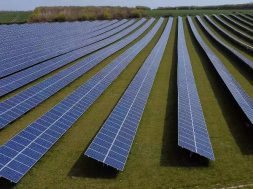
Solar power capacity addition fuelled by imports: How local panel producers can benefit from Make in India
Shri Raj Kumar Singh, a former bureaucrat and Member of Parliament from Bihar, took oath as the new Minister of Power, New and Renewable Energy on 3 September, 2017. Various factors contribute to making this role extremely crucial for the growth of our country. India is one of the largest power producers, but the per capita consumption still remains at very low levels. It has often been seen that GDP growth rate and the power generation capacity of the country is co-related, attributing to the importance of this function. Under the leadership of Shri Piyush Goyal, Indian power industry flourished, showing a 60 GW growth in thermal as well as 23 GW growth in renewable energy capacity.
The power transmission capacity also went up by an aggregate of 25 percent. Various policy initiatives like allocation of coal blocks, Discom rejuvenation scheme – UDAY, supply side reforms, green corridors program and the solar parks policy that he initiated during his 40 month tenure has helped the multiple stakeholders in the spectrum from generators to consumers. In 2016, India achieved 5 GW of solar capacity addition, practically doubling its capacity (to 10 GW) from 2015. The new minister has a huge task of maintaining the momentum of renewable-based installations in the country.The solar sector being in infancy needs to be supported continuously so that the dream of Prime Minister’s 100 percent electrification by 2018 and 100 GW of solar by the year 2022 is achieved.
Increasing rural electrification & latent demand
It must be noted that while more than 99 percent of the villages in India have the necessary infrastructure of transmission and distribution, only 78 percent of the total households have access to electricity. Central government in partnership with state governments and under the Deen Dayal Upadhyaya Gram Jyoti Yojana, needs to provide power to every household at a rate which is rationalised so that Discoms don’t shy away from providing power in rural areas and the objectives of UDAY scheme are not defeated. Despite latent demand being present, the plant load factor (PLF) of various power plants have reduced; to address the concerns, the government must also undertake demand side reforms across the country.
Need to stabilize solar sector
The solar sector has witnessed tremendous growth across the country and tariffs have decreased from Rs 10-12.76 per kWh in 2010-11 to Rs 2.44/per unit in 2017 (near about 90 percent fall). Aggressive reverse bidding has brought the tariff to a new low. With such low tariffs, and increase in raw material costs, there are concerns of projects not being commissioned. Government should rethink the mechanism it has adopted to discover the market price of power in order to avoid a market failure in renewable energy sector. Due to decrease in solar module costs, many discoms are now seeking renegotiations of the earlier contracted agreements for the power purchase agreement (PPA). Any step towards renegotiation of tariff will adversely affect renewable energy sector and hurt the investor confidence and lead to developers abandoning projects.
There are also concerns that this scenario can lead to increase in NPAs. Regulators must differentiate between renewable and non-renewable based power plants, since the only recurring cost for renewable based power plants are cost of finance.
To achieve the National Solar Mission target on time, the time gap between auctioning and awarding of projects need to be reduced. It has been observed that more than 25 states have failed to meet their renewable purchase obligation (RPO) targets. A new policy that charts out regulatory framework for enforcement of RPOs is required to push states to comply with RPOs.
New coal/lignite thermal power plants should abide by the Renewable Generation Obligation (RGO) of installation or procuring electricity from RE-based power plants.
Decreasing reliance on imports
Estimates state that 85-90 percent of the solar modules installed in India in 2016-17 were imported (from China and other countries) leading to a forex outflow of nearly $3 billion. Such high reliance on foreign countries will affect India’s energy security and make it difficult for domestic producers to survive. To realise the objectives of the Make in India mission, one suggestion is that the government should implement anti-dumping duties on imported solar modules so that local jobs and expertise are created in the country. There should also be encouragement for domestic manufacturers to enhance capacities. Given the WTO ruling on the Indian solar sector,the government should also continue to explore new ways to mandate procurement of domestically produced modules for public sector companies.
Reducing rate finance, favourable tax structure for manufacturers, increase in subsidies and incentives, better and easier allocation of resources (land and water), quicker regulatory approvals, higher budget allocation for R&D and clarity on GST are few other issues which the renewable sector is currently grappling with. A favourable policy environment is required to address the above issues. Shri Raj Kumar Singh, the new minister of Power, New and Renewable Energy has extensive administrative experience, and has always served with distinction. Therefore, we believe that he will lead the renewable energy revolution in India, championing solar; mirroring, or even surpassing his predecessor eventually.













